Project Selection Methods and Initial Documents for Maxima Limited
VerifiedAdded on 2023/01/18
|7
|1741
|96
Report
AI Summary
This report provides an in-depth analysis of project selection methods, essential for organizations like Maxima Limited to prioritize projects effectively. It explores the Project Management Body of Knowledge (PMBOK) and its influence on project management practices, including knowledge areas and process groups. The report examines various project selection techniques, such as cost-benefit ratio, economic models, payback period, Internal Rate of Return (IRR), scoring models, and discounted cash flow (DCF). Each method is explained with examples, highlighting its advantages and disadvantages. The report concludes that the selection method should be selected based on the complexity of the project and its potential benefits in terms of returns. The report provides valuable insights for project managers and business professionals seeking to optimize project selection and drive business success. The report also explains the use of these methods in the context of Maxima Limited.
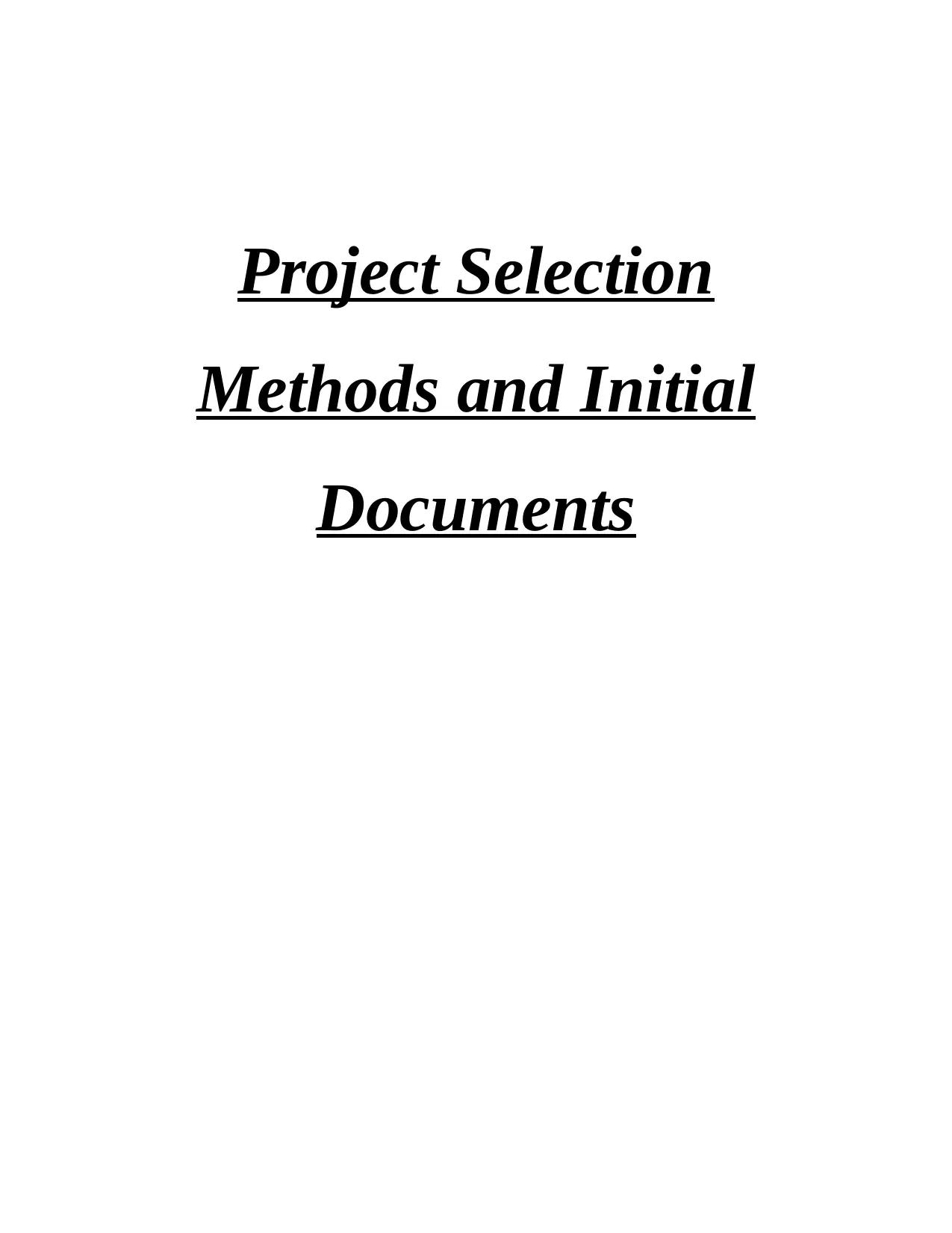
Project Selection
Methods and Initial
Documents
Methods and Initial
Documents
Paraphrase This Document
Need a fresh take? Get an instant paraphrase of this document with our AI Paraphraser
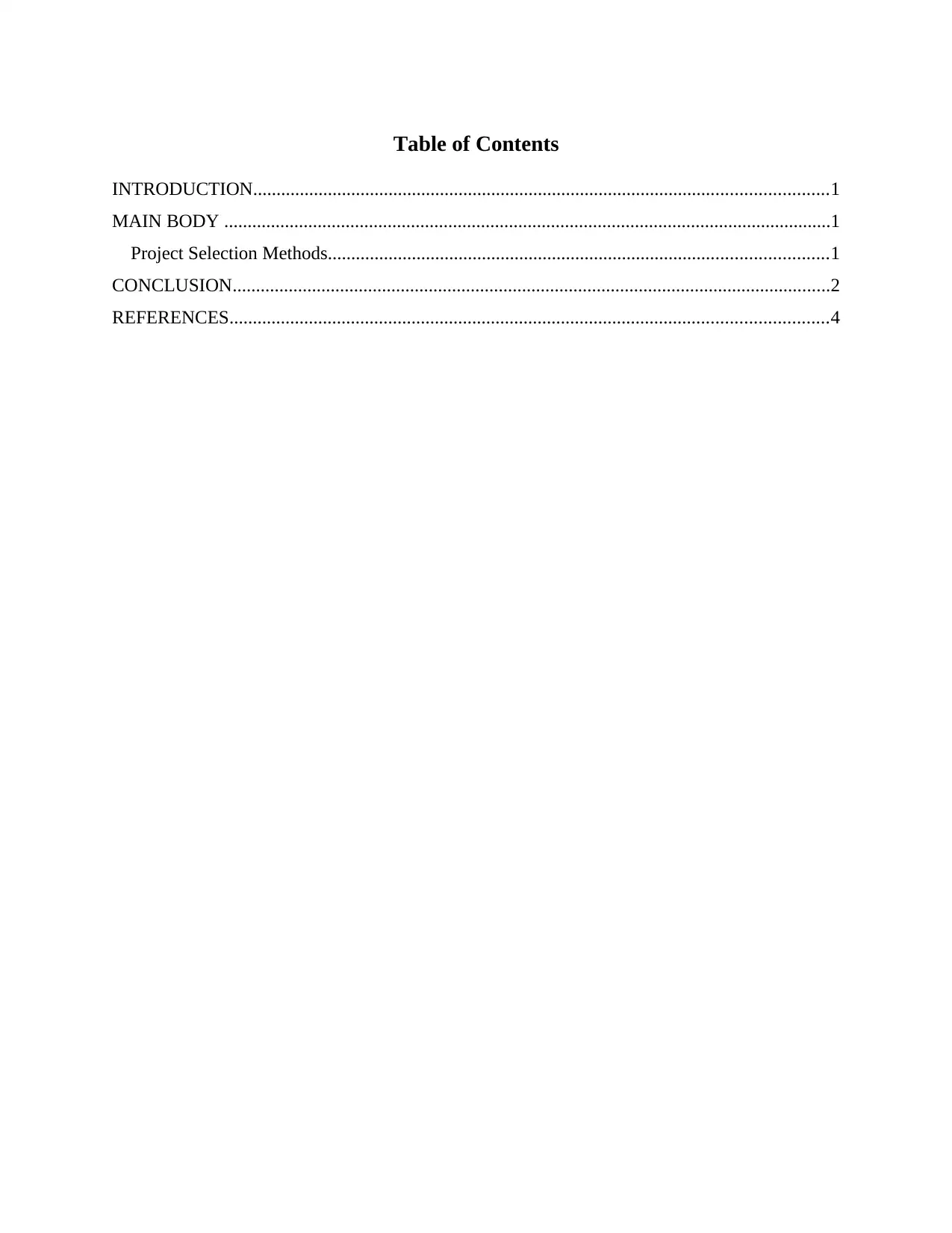
Table of Contents
INTRODUCTION...........................................................................................................................1
MAIN BODY ..................................................................................................................................1
Project Selection Methods...........................................................................................................1
CONCLUSION................................................................................................................................2
REFERENCES................................................................................................................................4
INTRODUCTION...........................................................................................................................1
MAIN BODY ..................................................................................................................................1
Project Selection Methods...........................................................................................................1
CONCLUSION................................................................................................................................2
REFERENCES................................................................................................................................4
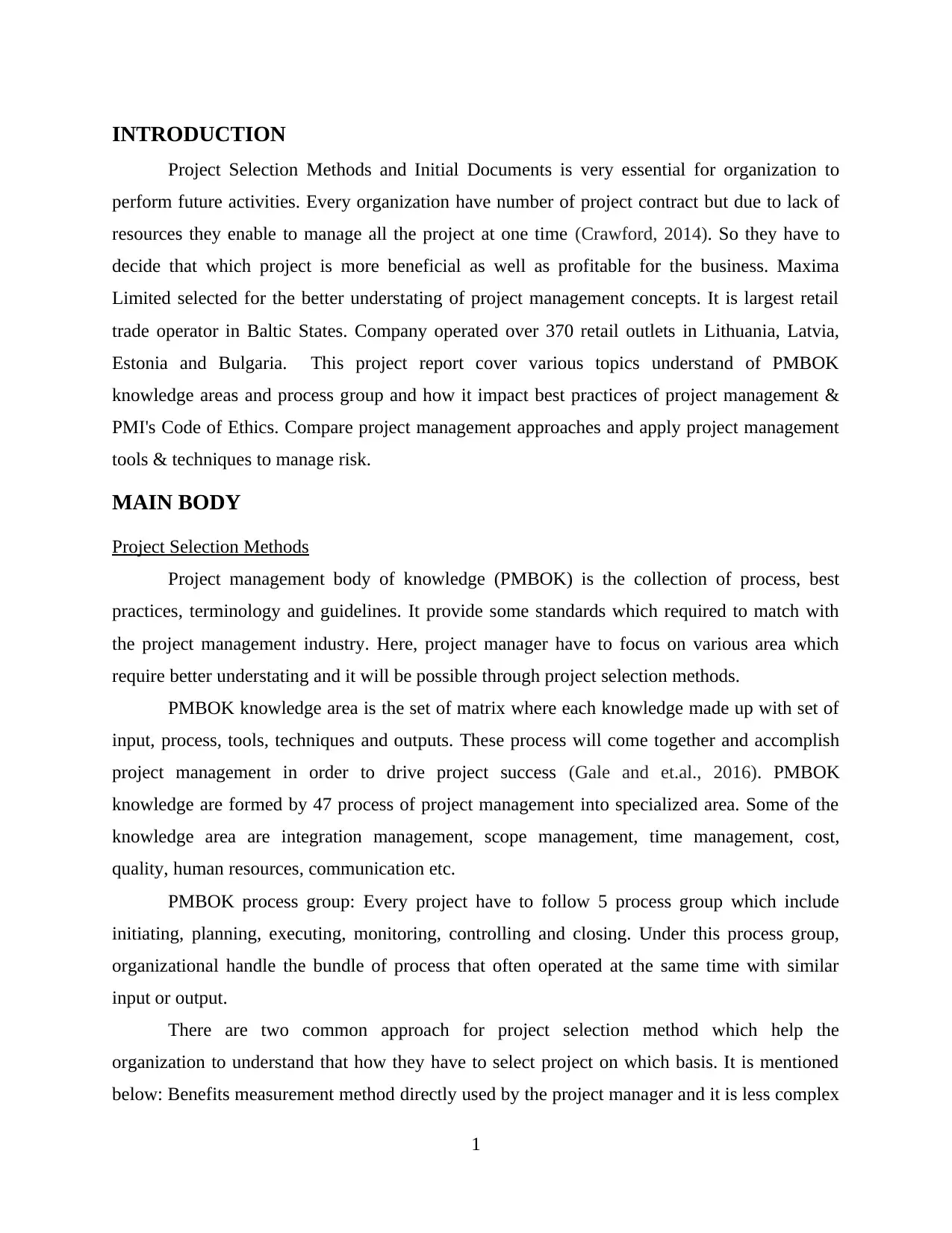
INTRODUCTION
Project Selection Methods and Initial Documents is very essential for organization to
perform future activities. Every organization have number of project contract but due to lack of
resources they enable to manage all the project at one time (Crawford, 2014). So they have to
decide that which project is more beneficial as well as profitable for the business. Maxima
Limited selected for the better understating of project management concepts. It is largest retail
trade operator in Baltic States. Company operated over 370 retail outlets in Lithuania, Latvia,
Estonia and Bulgaria. This project report cover various topics understand of PMBOK
knowledge areas and process group and how it impact best practices of project management &
PMI's Code of Ethics. Compare project management approaches and apply project management
tools & techniques to manage risk.
MAIN BODY
Project Selection Methods
Project management body of knowledge (PMBOK) is the collection of process, best
practices, terminology and guidelines. It provide some standards which required to match with
the project management industry. Here, project manager have to focus on various area which
require better understating and it will be possible through project selection methods.
PMBOK knowledge area is the set of matrix where each knowledge made up with set of
input, process, tools, techniques and outputs. These process will come together and accomplish
project management in order to drive project success (Gale and et.al., 2016). PMBOK
knowledge are formed by 47 process of project management into specialized area. Some of the
knowledge area are integration management, scope management, time management, cost,
quality, human resources, communication etc.
PMBOK process group: Every project have to follow 5 process group which include
initiating, planning, executing, monitoring, controlling and closing. Under this process group,
organizational handle the bundle of process that often operated at the same time with similar
input or output.
There are two common approach for project selection method which help the
organization to understand that how they have to select project on which basis. It is mentioned
below: Benefits measurement method directly used by the project manager and it is less complex
1
Project Selection Methods and Initial Documents is very essential for organization to
perform future activities. Every organization have number of project contract but due to lack of
resources they enable to manage all the project at one time (Crawford, 2014). So they have to
decide that which project is more beneficial as well as profitable for the business. Maxima
Limited selected for the better understating of project management concepts. It is largest retail
trade operator in Baltic States. Company operated over 370 retail outlets in Lithuania, Latvia,
Estonia and Bulgaria. This project report cover various topics understand of PMBOK
knowledge areas and process group and how it impact best practices of project management &
PMI's Code of Ethics. Compare project management approaches and apply project management
tools & techniques to manage risk.
MAIN BODY
Project Selection Methods
Project management body of knowledge (PMBOK) is the collection of process, best
practices, terminology and guidelines. It provide some standards which required to match with
the project management industry. Here, project manager have to focus on various area which
require better understating and it will be possible through project selection methods.
PMBOK knowledge area is the set of matrix where each knowledge made up with set of
input, process, tools, techniques and outputs. These process will come together and accomplish
project management in order to drive project success (Gale and et.al., 2016). PMBOK
knowledge are formed by 47 process of project management into specialized area. Some of the
knowledge area are integration management, scope management, time management, cost,
quality, human resources, communication etc.
PMBOK process group: Every project have to follow 5 process group which include
initiating, planning, executing, monitoring, controlling and closing. Under this process group,
organizational handle the bundle of process that often operated at the same time with similar
input or output.
There are two common approach for project selection method which help the
organization to understand that how they have to select project on which basis. It is mentioned
below: Benefits measurement method directly used by the project manager and it is less complex
1
⊘ This is a preview!⊘
Do you want full access?
Subscribe today to unlock all pages.

Trusted by 1+ million students worldwide
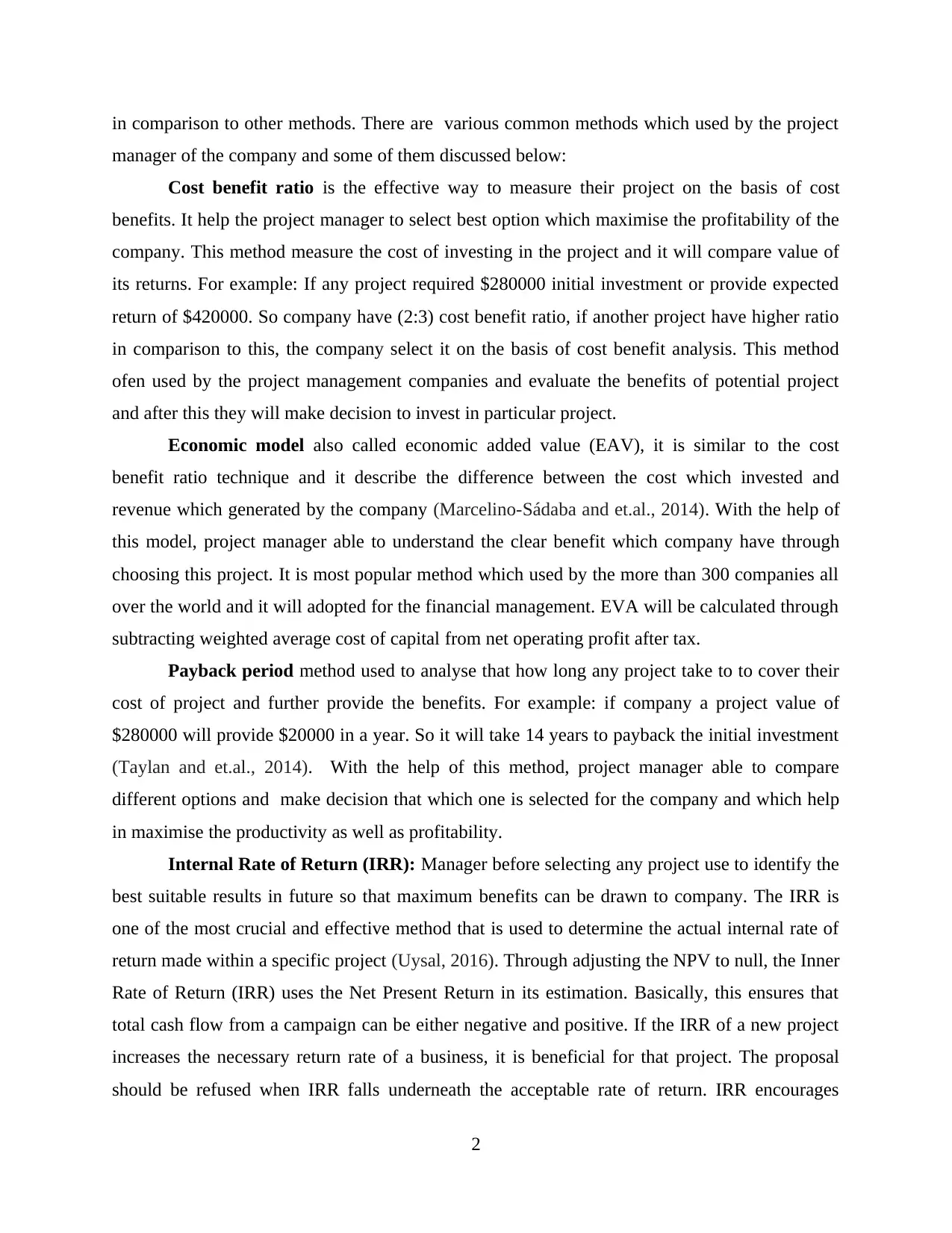
in comparison to other methods. There are various common methods which used by the project
manager of the company and some of them discussed below:
Cost benefit ratio is the effective way to measure their project on the basis of cost
benefits. It help the project manager to select best option which maximise the profitability of the
company. This method measure the cost of investing in the project and it will compare value of
its returns. For example: If any project required $280000 initial investment or provide expected
return of $420000. So company have (2:3) cost benefit ratio, if another project have higher ratio
in comparison to this, the company select it on the basis of cost benefit analysis. This method
ofen used by the project management companies and evaluate the benefits of potential project
and after this they will make decision to invest in particular project.
Economic model also called economic added value (EAV), it is similar to the cost
benefit ratio technique and it describe the difference between the cost which invested and
revenue which generated by the company (Marcelino-Sádaba and et.al., 2014). With the help of
this model, project manager able to understand the clear benefit which company have through
choosing this project. It is most popular method which used by the more than 300 companies all
over the world and it will adopted for the financial management. EVA will be calculated through
subtracting weighted average cost of capital from net operating profit after tax.
Payback period method used to analyse that how long any project take to to cover their
cost of project and further provide the benefits. For example: if company a project value of
$280000 will provide $20000 in a year. So it will take 14 years to payback the initial investment
(Taylan and et.al., 2014). With the help of this method, project manager able to compare
different options and make decision that which one is selected for the company and which help
in maximise the productivity as well as profitability.
Internal Rate of Return (IRR): Manager before selecting any project use to identify the
best suitable results in future so that maximum benefits can be drawn to company. The IRR is
one of the most crucial and effective method that is used to determine the actual internal rate of
return made within a specific project (Uysal, 2016). Through adjusting the NPV to null, the Inner
Rate of Return (IRR) uses the Net Present Return in its estimation. Basically, this ensures that
total cash flow from a campaign can be either negative and positive. If the IRR of a new project
increases the necessary return rate of a business, it is beneficial for that project. The proposal
should be refused when IRR falls underneath the acceptable rate of return. IRR encourages
2
manager of the company and some of them discussed below:
Cost benefit ratio is the effective way to measure their project on the basis of cost
benefits. It help the project manager to select best option which maximise the profitability of the
company. This method measure the cost of investing in the project and it will compare value of
its returns. For example: If any project required $280000 initial investment or provide expected
return of $420000. So company have (2:3) cost benefit ratio, if another project have higher ratio
in comparison to this, the company select it on the basis of cost benefit analysis. This method
ofen used by the project management companies and evaluate the benefits of potential project
and after this they will make decision to invest in particular project.
Economic model also called economic added value (EAV), it is similar to the cost
benefit ratio technique and it describe the difference between the cost which invested and
revenue which generated by the company (Marcelino-Sádaba and et.al., 2014). With the help of
this model, project manager able to understand the clear benefit which company have through
choosing this project. It is most popular method which used by the more than 300 companies all
over the world and it will adopted for the financial management. EVA will be calculated through
subtracting weighted average cost of capital from net operating profit after tax.
Payback period method used to analyse that how long any project take to to cover their
cost of project and further provide the benefits. For example: if company a project value of
$280000 will provide $20000 in a year. So it will take 14 years to payback the initial investment
(Taylan and et.al., 2014). With the help of this method, project manager able to compare
different options and make decision that which one is selected for the company and which help
in maximise the productivity as well as profitability.
Internal Rate of Return (IRR): Manager before selecting any project use to identify the
best suitable results in future so that maximum benefits can be drawn to company. The IRR is
one of the most crucial and effective method that is used to determine the actual internal rate of
return made within a specific project (Uysal, 2016). Through adjusting the NPV to null, the Inner
Rate of Return (IRR) uses the Net Present Return in its estimation. Basically, this ensures that
total cash flow from a campaign can be either negative and positive. If the IRR of a new project
increases the necessary return rate of a business, it is beneficial for that project. The proposal
should be refused when IRR falls underneath the acceptable rate of return. IRR encourages
2
Paraphrase This Document
Need a fresh take? Get an instant paraphrase of this document with our AI Paraphraser
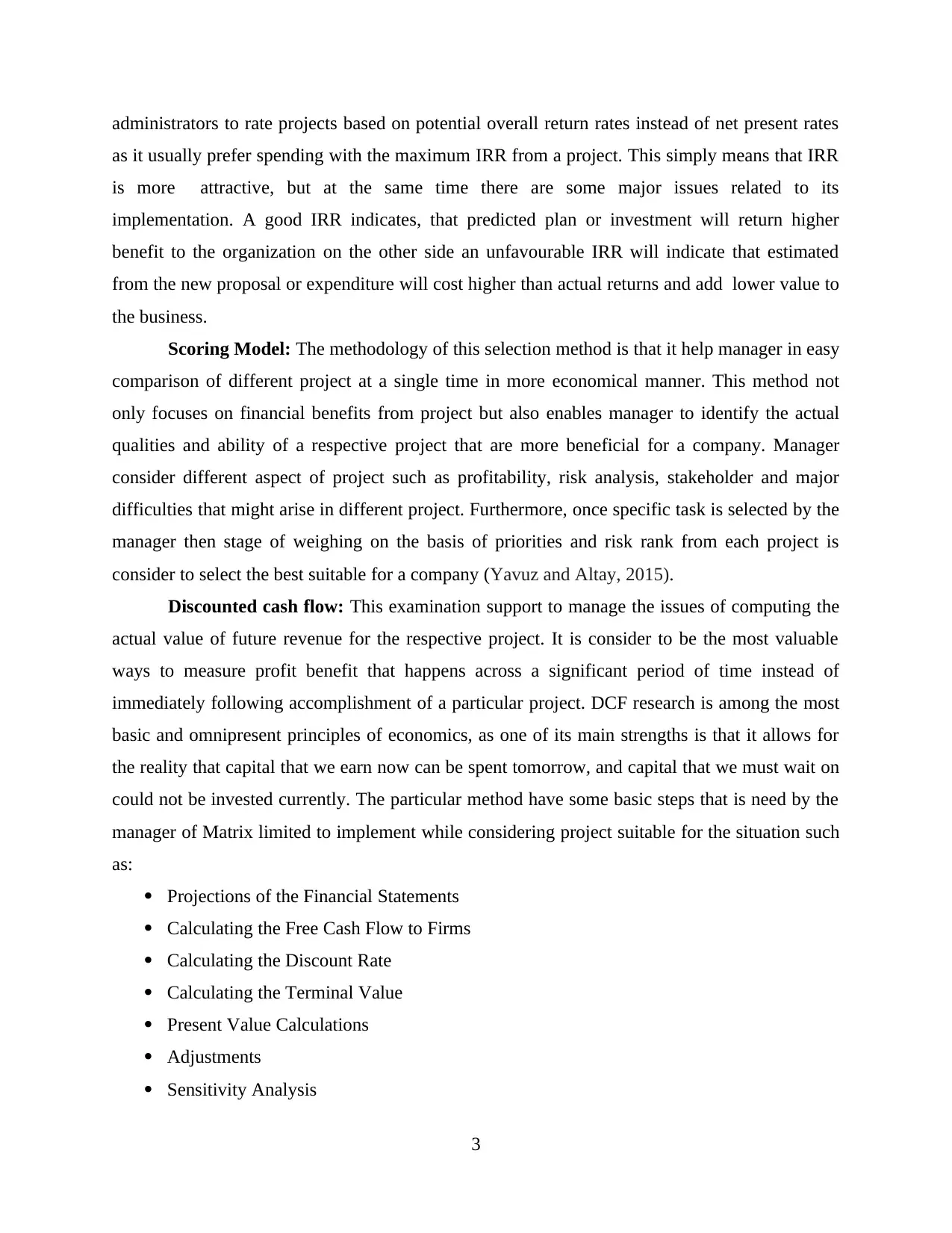
administrators to rate projects based on potential overall return rates instead of net present rates
as it usually prefer spending with the maximum IRR from a project. This simply means that IRR
is more attractive, but at the same time there are some major issues related to its
implementation. A good IRR indicates, that predicted plan or investment will return higher
benefit to the organization on the other side an unfavourable IRR will indicate that estimated
from the new proposal or expenditure will cost higher than actual returns and add lower value to
the business.
Scoring Model: The methodology of this selection method is that it help manager in easy
comparison of different project at a single time in more economical manner. This method not
only focuses on financial benefits from project but also enables manager to identify the actual
qualities and ability of a respective project that are more beneficial for a company. Manager
consider different aspect of project such as profitability, risk analysis, stakeholder and major
difficulties that might arise in different project. Furthermore, once specific task is selected by the
manager then stage of weighing on the basis of priorities and risk rank from each project is
consider to select the best suitable for a company (Yavuz and Altay, 2015).
Discounted cash flow: This examination support to manage the issues of computing the
actual value of future revenue for the respective project. It is consider to be the most valuable
ways to measure profit benefit that happens across a significant period of time instead of
immediately following accomplishment of a particular project. DCF research is among the most
basic and omnipresent principles of economics, as one of its main strengths is that it allows for
the reality that capital that we earn now can be spent tomorrow, and capital that we must wait on
could not be invested currently. The particular method have some basic steps that is need by the
manager of Matrix limited to implement while considering project suitable for the situation such
as:
Projections of the Financial Statements
Calculating the Free Cash Flow to Firms
Calculating the Discount Rate
Calculating the Terminal Value
Present Value Calculations
Adjustments
Sensitivity Analysis
3
as it usually prefer spending with the maximum IRR from a project. This simply means that IRR
is more attractive, but at the same time there are some major issues related to its
implementation. A good IRR indicates, that predicted plan or investment will return higher
benefit to the organization on the other side an unfavourable IRR will indicate that estimated
from the new proposal or expenditure will cost higher than actual returns and add lower value to
the business.
Scoring Model: The methodology of this selection method is that it help manager in easy
comparison of different project at a single time in more economical manner. This method not
only focuses on financial benefits from project but also enables manager to identify the actual
qualities and ability of a respective project that are more beneficial for a company. Manager
consider different aspect of project such as profitability, risk analysis, stakeholder and major
difficulties that might arise in different project. Furthermore, once specific task is selected by the
manager then stage of weighing on the basis of priorities and risk rank from each project is
consider to select the best suitable for a company (Yavuz and Altay, 2015).
Discounted cash flow: This examination support to manage the issues of computing the
actual value of future revenue for the respective project. It is consider to be the most valuable
ways to measure profit benefit that happens across a significant period of time instead of
immediately following accomplishment of a particular project. DCF research is among the most
basic and omnipresent principles of economics, as one of its main strengths is that it allows for
the reality that capital that we earn now can be spent tomorrow, and capital that we must wait on
could not be invested currently. The particular method have some basic steps that is need by the
manager of Matrix limited to implement while considering project suitable for the situation such
as:
Projections of the Financial Statements
Calculating the Free Cash Flow to Firms
Calculating the Discount Rate
Calculating the Terminal Value
Present Value Calculations
Adjustments
Sensitivity Analysis
3
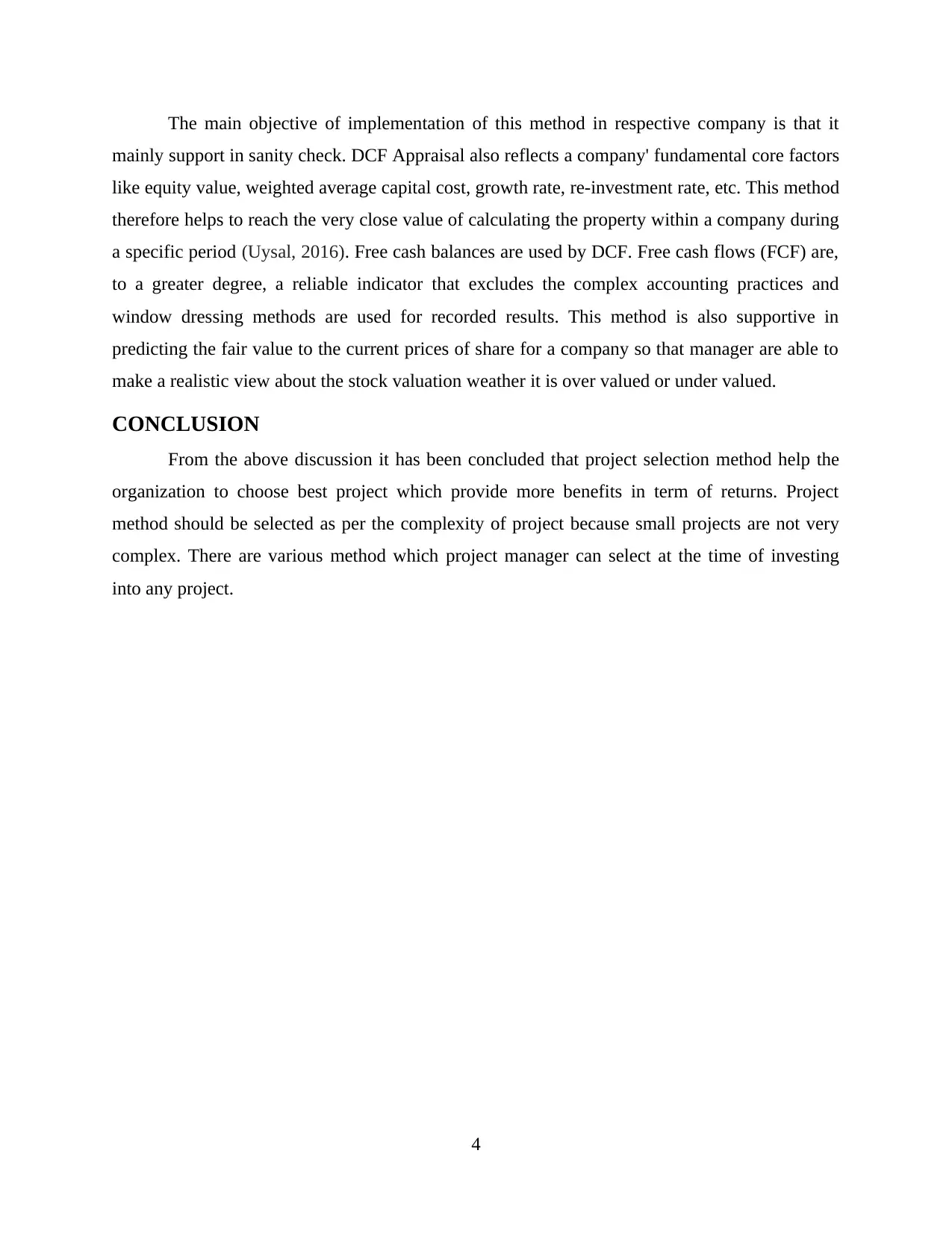
The main objective of implementation of this method in respective company is that it
mainly support in sanity check. DCF Appraisal also reflects a company' fundamental core factors
like equity value, weighted average capital cost, growth rate, re-investment rate, etc. This method
therefore helps to reach the very close value of calculating the property within a company during
a specific period (Uysal, 2016). Free cash balances are used by DCF. Free cash flows (FCF) are,
to a greater degree, a reliable indicator that excludes the complex accounting practices and
window dressing methods are used for recorded results. This method is also supportive in
predicting the fair value to the current prices of share for a company so that manager are able to
make a realistic view about the stock valuation weather it is over valued or under valued.
CONCLUSION
From the above discussion it has been concluded that project selection method help the
organization to choose best project which provide more benefits in term of returns. Project
method should be selected as per the complexity of project because small projects are not very
complex. There are various method which project manager can select at the time of investing
into any project.
4
mainly support in sanity check. DCF Appraisal also reflects a company' fundamental core factors
like equity value, weighted average capital cost, growth rate, re-investment rate, etc. This method
therefore helps to reach the very close value of calculating the property within a company during
a specific period (Uysal, 2016). Free cash balances are used by DCF. Free cash flows (FCF) are,
to a greater degree, a reliable indicator that excludes the complex accounting practices and
window dressing methods are used for recorded results. This method is also supportive in
predicting the fair value to the current prices of share for a company so that manager are able to
make a realistic view about the stock valuation weather it is over valued or under valued.
CONCLUSION
From the above discussion it has been concluded that project selection method help the
organization to choose best project which provide more benefits in term of returns. Project
method should be selected as per the complexity of project because small projects are not very
complex. There are various method which project manager can select at the time of investing
into any project.
4
⊘ This is a preview!⊘
Do you want full access?
Subscribe today to unlock all pages.

Trusted by 1+ million students worldwide
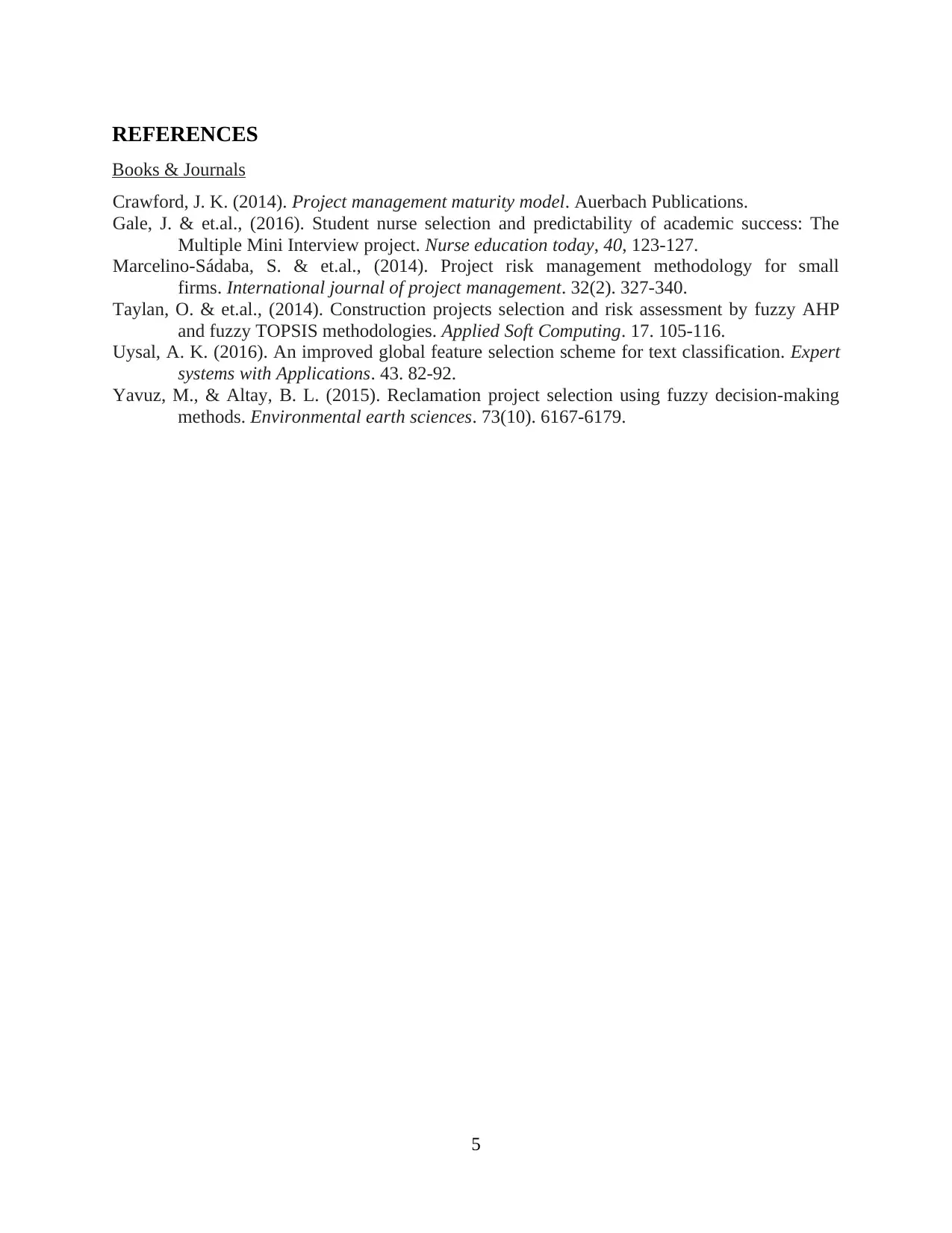
REFERENCES
Books & Journals
Crawford, J. K. (2014). Project management maturity model. Auerbach Publications.
Gale, J. & et.al., (2016). Student nurse selection and predictability of academic success: The
Multiple Mini Interview project. Nurse education today, 40, 123-127.
Marcelino-Sádaba, S. & et.al., (2014). Project risk management methodology for small
firms. International journal of project management. 32(2). 327-340.
Taylan, O. & et.al., (2014). Construction projects selection and risk assessment by fuzzy AHP
and fuzzy TOPSIS methodologies. Applied Soft Computing. 17. 105-116.
Uysal, A. K. (2016). An improved global feature selection scheme for text classification. Expert
systems with Applications. 43. 82-92.
Yavuz, M., & Altay, B. L. (2015). Reclamation project selection using fuzzy decision-making
methods. Environmental earth sciences. 73(10). 6167-6179.
5
Books & Journals
Crawford, J. K. (2014). Project management maturity model. Auerbach Publications.
Gale, J. & et.al., (2016). Student nurse selection and predictability of academic success: The
Multiple Mini Interview project. Nurse education today, 40, 123-127.
Marcelino-Sádaba, S. & et.al., (2014). Project risk management methodology for small
firms. International journal of project management. 32(2). 327-340.
Taylan, O. & et.al., (2014). Construction projects selection and risk assessment by fuzzy AHP
and fuzzy TOPSIS methodologies. Applied Soft Computing. 17. 105-116.
Uysal, A. K. (2016). An improved global feature selection scheme for text classification. Expert
systems with Applications. 43. 82-92.
Yavuz, M., & Altay, B. L. (2015). Reclamation project selection using fuzzy decision-making
methods. Environmental earth sciences. 73(10). 6167-6179.
5
1 out of 7
Related Documents
Your All-in-One AI-Powered Toolkit for Academic Success.
+13062052269
info@desklib.com
Available 24*7 on WhatsApp / Email
![[object Object]](/_next/static/media/star-bottom.7253800d.svg)
Unlock your academic potential
Copyright © 2020–2025 A2Z Services. All Rights Reserved. Developed and managed by ZUCOL.





